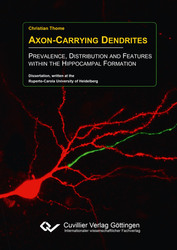| Departments | |
|---|---|
| Book Series (96) |
1378
|
| Nachhaltigkeit |
3
|
| Gesundheitswesen |
1
|
| Humanities |
2364
|
| Natural Sciences |
5406
|
| Mathematics | 229 |
| Informatics | 319 |
| Physics | 980 |
| Chemistry | 1363 |
| Geosciences | 131 |
| Human medicine | 243 |
| Stomatology | 10 |
| Veterinary medicine | 108 |
| Pharmacy | 147 |
| Biology | 835 |
| Biochemistry, molecular biology, gene technology | 121 |
| Biophysics | 25 |
| Domestic and nutritional science | 45 |
| Agricultural science | 1004 |
| Forest science | 201 |
| Horticultural science | 20 |
| Environmental research, ecology and landscape conservation | 148 |
| Engineering |
1793
|
| Common |
98
|
|
Leitlinien Unfallchirurgie
5. Auflage bestellen |
|
Advanced Search
Axon-Carrying Dendrites (English shop)
Prevalence, Distribution and Features within the Hippocampal Formation
Christian Thome (Author)Preview
Table of Contents, PDF (61 KB)
Extract, PDF (2.8 MB)
The ability to remember old events poses one of the most remarkable talents of the human brain. The hippocampus, a part of the limbic system, is suspected to play a key role in the transformation of new experiences into long term memory. Its neurons possess two specialized extensions to process information in a directed manner. Their widely ramified dendrites receive input from other cells, whereas a single axon transmits output to subsequent cells of the network. Dendrites and axon arise usually directly from the somatic compartment. However, we could show that in a large fraction of hippocampal neurons, the axon derives from one of the dendrites. This study focusses on the characterization of this particular anatomy and its influence on neuronal signal processing.
Using complementary techniques such as immunohistochemistry, electrophysiology and computer simulations we demonstrated that these axon-carrying dendrites constitute a privileged channel for excitatory synaptic input. This mechanism enables new ways to process information within the hippocampal structure and extends our knowledge about the biophysical foundations underlying memory formation.
Eine der bedeutsamsten Leistungen unseres Gehirns besteht in der Fähigkeit, sich an vielfältige Ereignisse zu erinnern, Informationen zu verknüpfen und aus Vergangenem zu lernen. Das Areal des Hippocampus gilt dabei als Schlüsselregion für den Transfer von neuen Erinnerungen ins Langzeitgedächtnis. Dortige Nervenzellen besitzen zwei spezialisierte Typen von Fortsätzen, welche eine gerichtete Informationsverarbeitung gewährleisten. Baumartig verzweigte Dendriten empfangen Eingangssignale, während ein einzelnes Axon das Ausgangssignal erzeugt und an nachgeschaltete Zellen weiterleitet. Beide Strukturen entspringen in der Regel direkt am Zellkörper. Wir konnten jedoch bei einer großen Anzahl von hippocampalen Zellen den Axon-Ursprung am Dendritenbaum nachweisen. Diese Studie widmet sich der Charakterisierung dieses anatomischen Phänomens und untersucht dessen Einfluss auf die zelluläre Signalverarbeitung.
Mittels verschiedener neurowissenschaftlicher Techniken konnten wir nachweisen, dass axon-tragende Dendriten einen neuen und elektrisch begünstigten Typus von Signaleingängen darstellen, der sich in Stärke und Netzwerkverhalten von klassischen Dendriten hervorhebt. Dieser Mechanismus ermöglicht neue Wege der Informationsverarbeitung im Hippocampus und erweitert damit unser Verständnis über die biophysikalischen Vorgänge, denen Lernen und Gedächtnisbildung zugrunde liegen.
| ISBN-13 (Hard Copy) | 9783736996243 |
| ISBN-13 (eBook) | 9783736986244 |
| Final Book Format | A5 |
| Language | English |
| Page Number | 130 |
| Lamination of Cover | matt |
| Edition | 1. |
| Publication Place | Göttingen |
| Place of Dissertation | Heidelberg |
| Publication Date | 2017-09-27 |
| General Categorization | Dissertation |
| Departments |
Neurology and neurosurgery
Common biology Genetics |
| Keywords | neuroscience, axon, dendrite, AIS, axon-carrying dendrite, synaptic integration, hippocampus, CA1 pyramidal cell, Neurowissenschaften, Elektrophysiologie |








